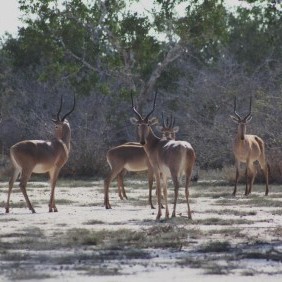Hirolas in Kenya

A lifeline for the world's most endangered antelope
Hirolas face a very high and real risk of extinction and are critically endangered- the highest risk category . Poaching, disease, habitat destruction and a severe drought in the 1980s have all played a part to the loss of this elegant species.
The problem
The loss of the Hirola would be the first mammal extinction on mainland Africa in modern human history- IUCN
Projections have forecast that over the next 50 years hirola numbers could dwindle to fewer than 20 individuals. This would be catastrophic and lead to their imminent extinction.
Unfortunately the majority of these animals are only found outside protected areas and along the Kenya-Somali border. Here its former range has been badly affected by prolonged civil and military conflicts. This means that it has been hard to put any protection in place for this elegant species in the last 40 years.
The solution
We are supporting the Hirola Conservation Programme which is dedicated to helping this species and the habitat in which it lives before it is gone forever.
In order to ensure they remain a part African wildlife we are working hard on all fronts. Our immediate tasks include employing and training local scouts, establishing an anti-poaching campaign and engaging the community in what is an urgent mission to turn around the fortune of this endemic creature.
All these actions will help develop a sustained area wide conservation programme. This programme is the first of its kind, desperately trying to save a species.
Project update
Abdullah Ali, who is working in Kenya to conserve the critically endangered hirola antelope, has been in contact to give us an update on his work this year. Since the 1970s when an estimated 14,000 antelope roamed the grasslands of Kenya and Somalia, various catastrophes have reduced their numbers to just 600.
One severe threat they face is the loss of their traditional grazing land. In the late 70s and 80s elephants were poached out the area they shared with the antelope. Elephants are important in maintaining open shrub and grassland, and without these megafauna, trees quickly began to dominate the landscape, transforming the area to forest. Although elephants are beginning to naturally recolonise the area, Ali and his team need to work much more quickly to transform the area back from forest cover to open grassland. The region is shared by the wildlife with Somali pastoralists who depend solely on their livestock for their livelihoods. So the team are working in partnership with the herders to achieve this, to ensure the landscape can provide a future not just for the hirola but for the herders and their animals too.
This year Ali’s team created four one-ha experimental plots, in which they are trialling various ways of removing trees – by cutting, uprooting or simply breaking branches – to see which methods are the most effective. Native grass seeds have been planted and fertilised. We’re waiting to hear how the trials have gone and what Ali plans to do next year to roll the habitat restoration programme out.
You can read the full Hirola Conservation Programme progress report here.
